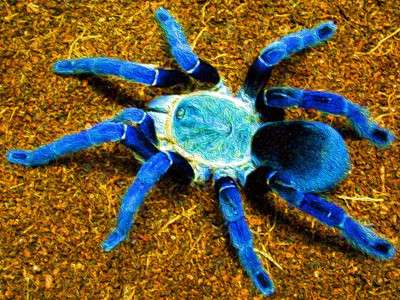
Description
Even while mature A. chalcodes exhibit sexual dimorphism, it is not as extreme as in other species. Males range from 49 to 61 mm in diameter, while females have a diameter of 49 to 68 mm and a leg span of about 98 mm. Like other tarantula species, desert tarantulas have a completely hair-covered body. They have two body parts, the cepholothorax and the abdomen, like other spiders do. The abdomen ranges from dark brown to black, whereas the cepholothorax is grey to dark brown. Below the tips of each of the eight legs is a pad made of iridescent hair. By biting their prey with their chelicerae’s fangs, tarantulas inject poison into their victims.
Geographic Distribution
Aphonopelma chalcodes, often known as the desert tarantula, is widespread in the Southwestern United States, particularly in New Mexico, Arizona, and Southern California. In arid soil, Aphonopelma chalcodes frequently grows. It constructs burrows by digging beneath stones or by utilizing rodents’ abandoned burrows. It may spend many years living in the same burrow.
Behavior
They should live alone because they are quiet and solitary animals. They should also be kept apart from other home pets to prevent stress and harm. Generally speaking, desert blond tarantulas are calm, relaxed creatures.

Care as Pet
Housing
For desert blond tarantulas, a 5- to 10-gallon plastic or glass tank with a safe lid and airflow is ideal. Avoid using excessively tall tanks because these spiders can get injuries from falls from vast heights and can climb.
Temperature and Humidity
Although these tarantulas are highly resilient to temperature changes because they are desert dwellers, it is advisable to keep the tank between 75 and 80 degrees Fahrenheit. A hydrometer can be used to measure the humidity level, which should be between 65 and 70 percent.
Water and Food
Feed live crickets and other insects, like as mealworms and roaches, to your desert blond tarantula. The insect should, in general, be smaller than the spider’s body. In order for your spider to receive nourishment, the crickets should be gut-loaded (given nutritious foods).
While young tarantulas can eat every day or every other day, adults often only eat once or twice per week. For advice on the right amount and feeding schedule for your specific spider, discuss with your veterinarian. Simply drop the live prey close to your spider to begin feeding. After 24 hours, throw away any leftover food since the spider may start to feel stressed.
A modest dish of fresh water should be constantly be kept in the enclosure. Because deep water can present a drowning risk, make sure your spider can enter and exit the dish with ease. Every day, replace the water.
Table





